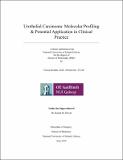| dc.contributor.advisor | Dwyer, Roisin | |
| dc.contributor.author | McHale, Teresa | |
| dc.date.accessioned | 2020-02-20T08:37:37Z | |
| dc.date.issued | 2020-02-19 | |
| dc.identifier.uri | http://hdl.handle.net/10379/15794 | |
| dc.description.abstract | Urothelial Carcinoma: Molecular Profiling & Potential Application in Clinical Practice
Abstract
Introduction: Urothelial carcinoma is characterised by a tendency to recurrence and risk of progression that necessitates life-long patient surveillance. Urine-based tests have been developed in an attempt to simplify follow-up protocols, easing the burden on patients and on health care resources. However, less than optimal performance of such tests has precluded their incorporation into management algorithms. This body of work examines urine tests with a molecular basis with a view to optimising performance and exploring potential causes of under-performance.
Methods: FISH testing using a standardised test, was compared prospectively with urine cytology, with biopsy and clinical follow-up. FISH analysis of available biopsy tissue and cellularity of urine samples were examined as potential confounding factors. LOH analysis using a panel of MS markers was examined in urothelial neoplasia in three study groups, namely subjects with flat vs papillary tumours, metastatic vs non-metastatic tumours and low grade vs. high grade tumours.
Results: FISH was not significantly better than cytology in the detection of urothelial carcinoma. Up to 24% of high grade urothelial carcinomas were FISH negative in urine because of a paucity of FISH-detectable molecular changes in the neoplastic cells. LOH analysis demonstrated considerable heterogeneity even within concurrent urothelial lesions in the same patient, and levels of molecular instability in morphologically normal urothelium in tumour patients that was comparable with the tumour itself.
Conclusion: Molecular heterogeneity is a feature of urothelial neoplasia and has implications for patient management. Molecular tests in urine examining a limited number of specific molecular changes (such as FISH) may produce false negative results. Future development of molecular-based urine tests will need to take account of the level of molecular abnormality in normal urothelium in urothelial carcinoma patients. | en_IE |
| dc.publisher | NUI Galway | |
| dc.rights | Attribution-NonCommercial-NoDerivs 3.0 Ireland | |
| dc.rights.uri | https://creativecommons.org/licenses/by-nc-nd/3.0/ie/ | |
| dc.subject | Bladder | en_IE |
| dc.subject | carcinoma | en_IE |
| dc.subject | urothelial | en_IE |
| dc.subject | molecular | en_IE |
| dc.subject | loss of heterozygosity | en_IE |
| dc.subject | fluorescence in-situ hybridization | en_IE |
| dc.subject | Medicine | en_IE |
| dc.subject | Medicine Nursing and Health Sciences | en_IE |
| dc.subject | Surgery | en_IE |
| dc.title | Urothelial carcinoma: Molecular profiling and potential application in clinical practice | en_IE |
| dc.type | Thesis | en |
| dc.local.note | This work investigates the diagnosis and follow-up of patients with bladder cancer, using the analysis of cells and nucleic acid present in urine samples. It reveals the potential difficulty in these analyses by virtue of overlapping features of cancer cells and normal bladder lining cells. | en_IE |
| dc.description.embargo | 2021-01-24 | |
| dc.local.final | Yes | en_IE |
| nui.item.downloads | 68 | |


